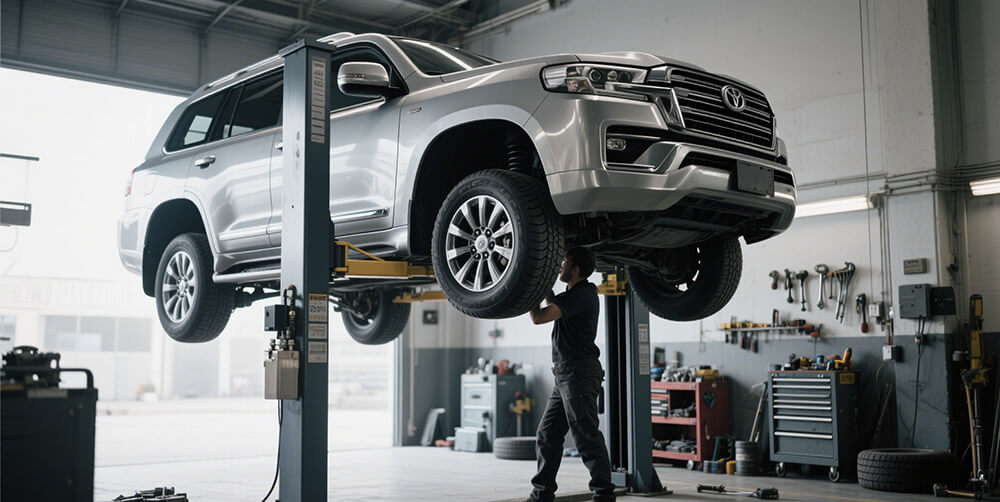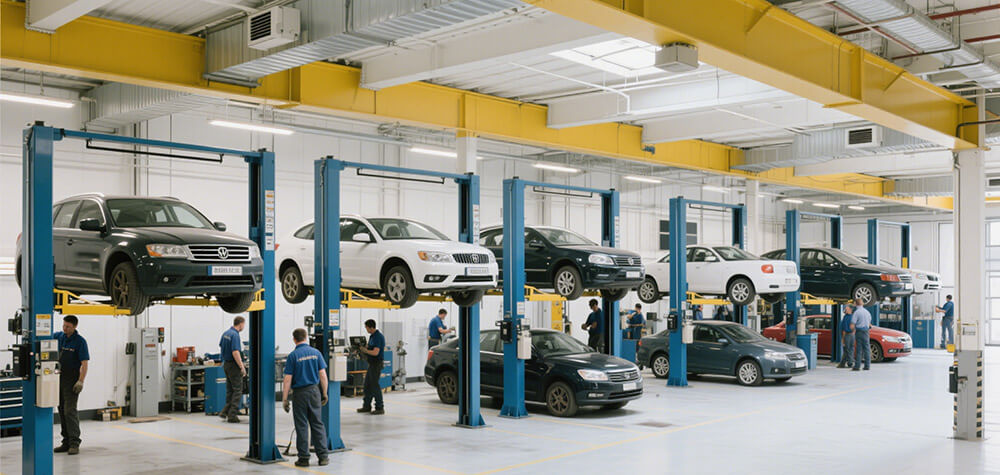Two Post Lift Height
Date: 2025-05-23 Categories: Business News
A two-post lift is a common piece of automotive maintenance equipment. The height of a two-post lift typically refers to its overall vertical dimension, which is crucial for ensuring it can safely and effectively service various vehicles. Here’s a detailed explanation:
Key Aspects of Two-Post Lift Height
-
Overall Height
- The total vertical height from the ground to the top of the lift’s structure (including the overhead frame or crossbeams).
- Typical Range: Most standard two-post lifts have an overall height of 2.8 to 3.5 meters (9 to 11.5 feet), but this can vary by model and manufacturer.
- Influence Factors:
- Vehicle Clearance Requirements: Lifts must provide enough vertical space to raise vehicles off the ground for maintenance (e.g., tire replacement, undercarriage inspection).
- Ceiling Height of the Workshop: The lift’s height must be compatible with the workshop’s ceiling to avoid installation issues.
-
Lifting Height (Raising Capacity)
- The maximum vertical distance the lift can raise a vehicle from the ground.
- Typical Range:
- Standard models: 1.6 to 2.1 meters (5.2 to 6.9 feet).
- Heavy-duty or specialized models: Up to 2.5 meters (8.2 feet) or more.
- Importance:
- Ensures mechanics can work comfortably under the vehicle.
- Determines the lift’s suitability for different vehicle types (e.g., sedans, SUVs, trucks).
-
Minimum Height (Folded/Retracted State)
- The lift’s height when not in use (lowered to the ground).
- Typical Range: 0.1 to 0.3 meters (4 to 12 inches).
- Role:
- Allows vehicles to drive onto the lift without obstruction.
- Reduces the lift’s space occupation in the workshop.
Factors Affecting Two-Post Lift Height
| Factor | Impact on Height |
|---|---|
| Vehicle Type | Lifts for trucks or buses require greater lifting height than those for sedans. |
| Workshop Ceiling Height | The lift’s overall height must be at least 0.5 meters (1.6 feet) lower than the ceiling to ensure safe operation. |
| Lift Structure Design | Models with overhead crossbeams may have greater overall height than column-only designs. |
| Safety Regulations | Local safety standards may specify minimum clearances for lift operation. |
Common Height Specifications (Example)
| Lift Model | Overall Height | Lifting Height | Suitable Vehicle Type |
|---|---|---|---|
| Light-duty two-post lift | 3.0 m (9.8 ft) | 1.8 m (5.9 ft) | Sedans, small SUVs |
| Heavy-duty two-post lift | 3.5 m (11.5 ft) | 2.2 m (7.2 ft) | Trucks, large SUVs, commercial vehicles |
Considerations When Choosing a Two-Post Lift
- Workshop Space: Measure the ceiling height and ensure the lift fits without compromising safety.
- Vehicle Fleet: Choose a lifting height that accommodates the tallest vehicles in your service scope.
- Safety Clearance: Maintain at least 0.3 meters (1 foot) of clearance between the lift and the ceiling or other overhead obstacles.
- Manufacturer Specifications: Always refer to the lift’s technical manual for precise height and capacity data.
Summary
The height of a two-post lift directly impacts its usability, safety, and compatibility with workshop spaces and vehicle types. Balancing these factors ensures efficient and safe vehicle maintenance operations. For specific models, consult the manufacturer’s documentation for accurate height parameters.
Tags:
Share:
Related
- What is the difference between a two-post lift and a gantry lift?
- How much does wheel balancing cost?
- Wheel Balancer calibration method
- Is it worth changing tires yourself?
- How much does it cost to change a tire?
- What is a tire changer called?
- Are jack stands safe?
- Jack Stands shopping guide: How to choose the most suitable load-bearing model?



